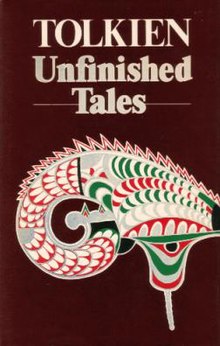Unfinished Tales
This article includes a list of references, related reading, or external links, but its sources remain unclear because it lacks inline citations. (July 2013) |
 First edition | |
| Author | J. R. R. Tolkien, edited by Christopher Tolkien |
|---|---|
| Language | English |
| Genre | Fantasy fiction |
| Publisher | George Allen & Unwin |
Publication date | 1980 |
| Publication place | United Kingdom |
| Media type | Print (hardback & paperback) |
Unfinished Tales (full title Unfinished Tales of Númenor and Middle-earth) is a collection of stories and essays by J. R. R. Tolkien that were never completed during his lifetime, but were edited by his son Christopher Tolkien and published in 1980.
Unlike The Silmarillion, for which the narrative fragments were modified to connect into a consistent and coherent work, the Unfinished Tales are presented as Tolkien left them, with little more than names changed (the author having had a confusing habit of trying out different names for a character while writing a draft). Thus some of these are incomplete stories, while others are collections of information about Middle-earth. Each tale is followed by a long series of notes explaining inconsistencies and obscure points.
As with The Silmarillion, Christopher Tolkien edited and published Unfinished Tales before he had finished his study of the materials in his father's archive.[citation needed] Unfinished Tales provides more detailed information about characters, events and places mentioned only briefly in The Lord of the Rings. Versions of such tales including the origins of Gandalf and the other Istari (Wizards), the death of Isildur and the loss of the One Ring in the Gladden Fields, and the founding of the kingdom of Rohan help expand knowledge about Middle-earth.
The commercial success of Unfinished Tales demonstrated that the demand for Tolkien's stories several years after his death was not only still present, it was growing. Encouraged by the result, Christopher Tolkien embarked upon the more ambitious twelve-volume work entitled The History of Middle-earth which encompasses nearly the entire corpus of Tolkien's writings about Middle-earth.
Contents
Part One: The First Age:
- "Of Tuor and his Coming to Gondolin"
- "Narn i Hîn Húrin (The Tale of the Children of Húrin)"
Part Two: The Second Age:
- "A Description of the Island of Númenor"
- "Aldarion and Erendis: The Mariner's Wife"
- "The Line of Elros: Kings of Númenor"
- "The History of Galadriel and Celeborn"
Part Three: The Third Age:
- "The Disaster of the Gladden Fields"
- "Cirion and Eorl and the Friendship of Gondor and Rohan"
- "The Quest of Erebor"
- "The Hunt for the Ring"
- "The Battles of the Fords of Isen"
Part Four


